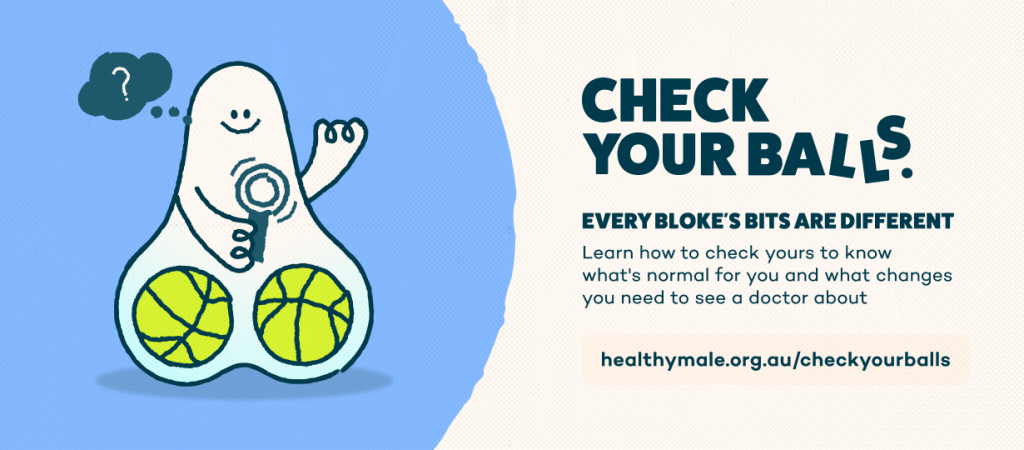Checking on the health of your testicles should be as regular as brushing your teeth, but how do you know what’s a normal part of your anatomy and what needs a doctor’s attention?
Here we explain what your testicles should feel like, and what might be causing lumps or bumps on your testicles, scrotum, or scrotal contents.
What are testicles?
You might usually refer to them as your ball and balls, testicle and testicles, but the correct terminology is your testis (one) and testes (two). The testicles are oval shaped glands that sit in a pouch of skin called your scrotum, under the base of your penis.
They’re important parts of the male reproductive system, responsible for making sperm and the hormone testosterone. In the scrotum, testicles are about 2°C cooler than normal core body temperature, which is important for sperm production.
This is why the scrotum contracts and brings the testes closer to the body in cold weather and relaxes in hotter weather.

What should your testicles feel like?
When you feel your testicles through the scrotum, they should feel smooth, without any lumps or bumps. Your testicles should feel firm but not hard if you give them a gentle squeeze.
When you feel the rest of your scrotum and its contents, you’ll come across the epididymis on the underside of the scrotum. The epididymis lies at the back of each testicle and it feels like a thin, coiled tube.
What shape and size should your testicles be?
Adults’ testicles range in size range in size from about 15 mL to 35 mL (like a small chicken egg). If you’ve noticed a difference between your left and right testicle, remember it’s common for one testicle be a bit bigger than the other and for one testicle hang slightly lower.
Small testicles (about the size of a grape) after puberty are a strong indication of Klinefelter syndrome.
What can cause testicles to look and feel different to how they should?
The testicles and scrotum should not feel painful or uncomfortable when handled gently. There are certain health conditions that can change the way your testicles look and feel.
Your testicles look or feel lumpy and/or bumpy
Your testicles may have lumps and bumps on them sometimes. Even if a lump or bump is painless, you should see your doctor about it as soon as possible. Although most testicular lumps are nothing to worry about, they can be a sign of testicular cancer. Although it’s rare, testicular cancer is the second most common cancer in males aged 18 to 39. The good news is that if it’s caught early, testicular cancer has a high cure rate of over 95%.
Is it normal for a testicle to not be smooth?
No, your testicles should feel smooth so if you feel a lump you should see a doctor as soon as possible.
Your testicles look or feel swollen
Your testicles may become swollen or enlarged due to a bacterial infection like orchitis, testicular cancer or testicular torsion.
Your scrotum looks or feels full of fluid
If your scrotum looks or feels like it’s full of fluid on one or both sides, you may have a hydrocele. A hydrocele may be caused by inflammation or injury but it’s not usually painful. If your scrotum looks or feels like it’s full of fluid, you should visit your doctor who may take an ultrasound to investigate what’s causing this.
Your scrotum looks or feels veiny
If your scrotum looks veiny (usually on the left-hand side), it may be caused by a condition called varicocele. This is an enlargement of the veins that sit within the scrotum and feels kind of wormy.
The cause of varicoceles is not fully understood. While varicoceles don’t often require any treatment, they can reduce fertility, so it’s worth talking about it with your doctor if you have a varicocele and are having trouble conceiving a baby.
If you notice other signs and symptoms alongside your testicles looking veiny, such as your testicles becoming swollen or painful, or noticing a lump on your testicles, you should visit your doctor.
Your epididymis (the thin tube connected to your testicles) looks swollen
If your epididymis becomes swollen and tender, you may have a condition called epididymitis.
You should see your doctor as soon as possible if your epididymis feels swollen or sore as you may need to get checked for sexually transmitted infections (one of the most common causes of epididymitis is chlamydia).
Cysts (collections of fluid that feel like small water-filled balloons) are common in or on the epididymis. Some will be too small to notice but they can get as big as the testicle. Epididymal cysts are not usually painful and don’t often have any complications.
If you notice one and it’s not causing you any trouble, just keep an eye on it. They usually go away on their own. It might be worth mentioning to your doctor for peace of mind. If the cyst gets bigger, or painful, make sure you see your doctor.
How to make sure your testicles are healthy
Watch our short video to learn how to check your testicles for any changes through a self-testicular examination.
If you’ve carried out a self-examination and have noticed any of the above changes to your testicles, visit your GP, who will be able to provide you with more information and next steps.














